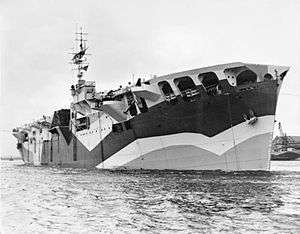HMS Pretoria Castle (F61)
HMS Pretoria Castle (F61) was an armed merchant cruiser and escort aircraft carrier of the Royal Navy that saw service during World War II. She had previously been the ocean liner Pretoria Castle of the Union-Castle Line; built at Harland & Wolff shipyards in Belfast, Northern Ireland and launched in 1938.
 HMS Pretoria Castle | |
| History | |
|---|---|
| Name: | Pretoria Castle |
| Port of registry: |
|
| Builder: | Harland & Wolff |
| Yard number: | 1006[1] |
| Launched: | 12 October 1938 |
| Completed: | 18 April 1939[1] |
| Fate: | Requisitioned by Royal Navy in October 1939 |
| History | |
| Name: | HMS Pretoria Castle |
| Commissioned: | 28 November 1939 |
| Decommissioned: | August 1942 |
| Refit: | Converted from armed merchantman to escort carrier |
| Commissioned: | 29 July 1943 |
| Decommissioned: | 26 Jan 1946 |
| Fate: | Sold back to the Union-Castle Line in 1946 and converted to a passenger ship |
| Name: | RMMV Warwick Castle |
| Port of registry: |
|
| Acquired: | 1946 |
| Fate: | scrapped, July 1962 |
| General characteristics | |
| Displacement: | 23,450 tons |
| Length: | 594 ft (181.1 m) |
| Beam: | 76 ft (23.2 m) |
| Draught: | 29 ft (8.8 m) |
| Propulsion: | Diesel, 16,000 bhp |
| Speed: | 18 knots (33 km/h; 21 mph) |
| Aircraft carried: | 21 |
She was requisitioned by the Royal Navy in October 1939, and converted to an armed merchant cruiser with 6-inch (150 mm) and 3-inch (76 mm) guns, entering service in November 1939. In this role she served mainly in the South Atlantic.
In July 1942 she was bought outright by the Navy for conversion to an escort carrier at the Swan Hunter shipyards in Tyne and Wear. She was commissioned in this role in July 1943 and was operated as a trials and training carrier, seeing no active combat service.
In 1945 she twice became part of aviation history, firstly when British test pilot Captain Eric "Winkle" Brown landed a Bell Airacobra Mk. 1 on her flight deck - the first carrier landing made using an aircraft with a tricycle undercarriage, due to a declared emergency during initial trials for rubber deck landings planned for future carriers, and then by hosting the first ever landings and take-offs by a glider, performed by John Sproule in a Slingsby T.20 as part of research into 'Round-down' turbulence. On 11 August 1946, while moored on the Clyde, a Gloster Meteor was used for deck handling trials which later led to flight trials on other carriers.[2]
Post-war, the ship was sold back to the Union-Castle Line in 1946 and converted back to a passenger liner, being renamed the Warwick Castle and operating on routes from England to South Africa. She was eventually sold and scrapped in Barcelona in 1962.
Notes
- McCluskie, Tom (2013). The Rise and Fall of Harland and Wolff. Stroud: The History Press. p. 146. ISBN 9780752488615.
- url=http://www.naval-history.net/xGM-Chrono-05CVE-HMS_Pretoria_Castle.htm accessdate=Feb 2016
References
- Osborne, Richard; Spong, Harry & Grover, Tom (2007). Armed Merchant Cruisers 1878–1945. Windsor, UK: World Warship Society. ISBN 978-0-9543310-8-5.
Further reading
- Wings of the Weird and Wonderful
- Wings on My Sleeve
External links
- Drury, Tony. "A history of HMS Pretoria Castle". Royal Navy Research Archive.
- "HMS Pretoria Castle (F 61)". uboat.net.
- "The Late Great Ocean Liners: UK/Union Castle". Archived from the original on 17 March 2006.
External links
| Wikimedia Commons has media related to HMS Pretoria Castle (F61). |